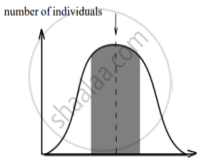Advertisements
Advertisements
Question
Very short answer question.
State the Hardy – Weinberg equilibrium.
Solution
- The Hardy-Weinberg equilibrium law states that at the equilibrium point, both the gene (allele) frequency and genotypic frequency remain constant from generation to generation.
- generation, in the diploid, sexually reproducing, large, free interbreeding population in which mating is random, and there is the absence of any other factors that change the allele frequency
APPEARS IN
RELATED QUESTIONS
What does the following equation represent? Explain.
p2 + 2pq + q2 = 1
p2 + 2pq + q2 = 1. Explain this algebraic equation on the basis of Hardy Weinberg's principle.
State Hardy-Weinberg’s principle.
Differentiate between Directional natural selection and Disruptive natural selection.
Multiple choice question.
In Hardy - Weinberg equation, the frequency of homozygous recessive individual is represented by:
A population will not exist in Hardly Weiberg equilibrium if ____________.
For the MN-blood group system, the frequencies of M and N alleles are 0.7 and 0.3, respectively. The expected frequency of MN-blood group bearing organisms is likely to be ______.
"Migration may enhance or blurr the effects of selection". Comment.
The graphs below show three types of natural selection. The shaded areas marked with arrows show the individuals in the population who are not selected. The dotted vertical lines show the statistical means.
 |
 |
 |
| character Graph A |
character Graph B |
character Graph C |
- What names are given to the types of selection shown in graphs A, B and C?
- After the selection has operated for several generations in the above populations indicated as, Graph A, B and C, graphically illustrate the probable results.
A population of 200 fruit flies is in Hardy Weinberg equilibrium. The frequency of the allele (a) 0.4. Calculate the following:
The number of homozygous dominant fruit flies.
